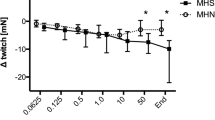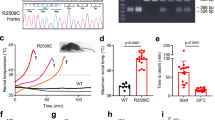Abstract.
Administration of 5-HT2 receptor agonists induced malignant hyperthermia (MH) in susceptible pigs. Furthermore, the 5-HT2 receptor antagonist ritanserin prevented 5-HT-induced porcine MH. It has been shown that 5-HT2 receptor agonists induce marked contractures in skeletal muscle specimens from MH susceptible (MHS) but not in specimens from normal patients. The purpose of this study was to investigate the effects of ritanserin on halothane-induced contractures in muscle specimens from MHS patients.
Twenty-five patients aged 8–56 years (29.5±13.6) classified as MHS by the in vitro contracture test (IVCT) with halothane and caffeine according to the protocol of the European MH Group participated in this study. Muscle specimens were pretreated with ritanserin 10 µmol/l (n=14), 20 µmol/l (n=14) and 100 µmol/l (n=12) for 10 min and subsequently halothane was added incrementally (0.11–0.22–0.44 mmol/l) to the tissue bath as described in the European MH protocol. The results of the halothane contracture test were used as control.
Following administration of halothane, muscle contractures reached a maximum of 16.9±4.2 mN. Ritanserin led to a significant inhibition of halothane-induced contractures in MHS muscles. Following pretreatment with ritanserin, halothane-induced contracture maximum was significantly smaller with 7.5±3.1 mN after 10 µmol/l ritanserin, 4.9±1.5 mN after 20 µmol/l ritanserin and 0.5±0.2 mN after 100 µmol/l ritanserin than without pretreatment. Administration of ritanserin induced at all concentrations a decrease in muscle twitch height. Increase in muscle twitch following halothane was reduced in a concentration-dependent manner by ritanserin. The presented findings indicate that 5-HT might be involved in the mechanisms of halothane-induced MH in humans. Further studies have to determine the pathophysiological role of the 5-HT system in MH, and whether ritanserin could be an alternative for treatment or prevention of halothane-induced MH.
Similar content being viewed by others
Author information
Authors and Affiliations
Additional information
Electronic Publication
Rights and permissions
About this article
Cite this article
Wappler, F., Scholz, J., Fiege, M. et al. 5-HT2 receptor antagonist-mediated inhibition of halothane-induced contractures in skeletal muscle specimens from malignant hyperthermia susceptible patients. Naunyn-Schmiedeberg's Arch Pharmacol 360, 376–381 (1999). https://doi.org/10.1007/s002109900062
Received:
Accepted:
Issue Date:
DOI: https://doi.org/10.1007/s002109900062




